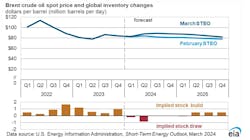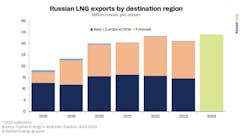In its March issue Short-Term Energy Outlook (STEO), the US Energy Information Administration (EIA) said it expects the Brent crude oil spot price will average $88/bbl in second-quarter 2024, up $4/bbl from the February STEO, and EIA now expects the Brent price will average $87/bbl this year, compared with $82.4/bbl forecasted in the February STEO.
The increase in oil price forecast reflects the extended OPEC+ production cuts, officially announced on Mar. 4. The OPEC+ voluntary production cuts are an extension of the existing production cuts that were announced on Nov. 30, 2023, and are now extended through second-quarter 2024. The announcement also included an additional voluntary production cut from Russia.
“As a result of OPEC+ extending crude oil production cuts, we have reduced our forecast for global oil production growth in 2024. The lower growth contributes to significant global oil inventory declines in our forecast for second-quarter 2024,” EIA said. EIA now forecasts global oil inventories will fall by 900,000 b/d in second-quarter 2024; last month, EIA had expected inventories to remain relatively unchanged in the second quarter.
EIA expects that the tighter oil market balance during 2024 will keep the Brent price above current levels, averaging $88/bbl in second-quarter 2024, $4/bbl higher than in last month’s STEO. EIA expects it will remain relatively flat for the rest of the year before increasing inventories (when OPEC+ supply cuts are set to expire) start putting slight downward pressure on the price in 2025.
Following the new OPEC+ voluntary production cuts, EIA anticipates a global liquid fuels production increase of 400,000 b/d in 2024, a decrease from the 600,000 b/d growth projected in last month's STEO and significantly lower than the 1.8 million b/d rise observed in 2023.
According to EIA, despite the limitations imposed by OPEC+ production cuts on overall growth for 2024, non-OPEC+ production is expected to surge by 1.5 million b/d, primarily propelled by four nations in the Americas—namely, the US, Guyana, Brazil, and Canada. This expansion offsets the decline in crude oil production subjected to the OPEC+ agreement, which is projected to decrease by 1.1 million b/d in 2024.
The forecast for global liquids fuel production indicates a 2 million b/d increase in 2025, with OPEC+ crude oil production expected to rise by 900,000 b/d as the existing OPEC+ production targets expire by end-2024. Meanwhile, production not bound by the OPEC+ agreement is forecasted to increase by an additional 1.1 million b/d.
US refinery operations
In late January and February 2024, US refinery inputs experienced a sharp decline due to harsh winter conditions, planned maintenance activities along the Gulf Coast, and a major unplanned outage in the Midwest. EIA expects low refinery utilization to continue as the bp plc Whiting outage lingers alongside normal seasonal maintenance.
The anticipation of lower-than-expected crude oil inputs in EIA’s projections leads to increased builds in US commercial crude oil inventories. In February, crude oil inventories are estimated to have surged by 21 million bbl, a significant deviation from the forecasted 9-million-bbl increase in EIA’s February STEO. Additionally, EIA’s projections for end-of-month crude inventories in March have been adjusted upward by 16 million bbl compared with the previous STEO.
Despite these adjustments, EIA expects OPEC+ production restraint to contribute to a reduction in US crude oil inventory draws later in the year, aligning the forecast more closely with its expectations outlined in the February STEO as the market approaches the summer of 2024.
Furthermore, refinery outages are impacting motor gasoline production and inventories. Combined inventories in the East Coast and Gulf Coast regions were about 5% below the 5-year (2019–2023) average by end-February. Given that these regions are significant in gasoline production and consumption, their lower inventories exert a notable influence on total US gasoline availability and prices. EIA projects that US retail gasoline prices in second-quarter 2024 will average almost $3.60/gal, a nearly 20¢/gal increase from the February STEO.


